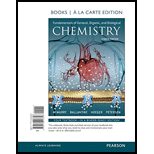
(a)
Interpretation:
The scientific notation should be identified for the given significant figure.
Concept Introduction:
Significant figures: The term significant figures refer to the number of important single digits in the co-efficient of an expression in scientific notation (for example 0 to 9 inclusive).
In other words precision of measurements, the value recorded should use all the digits known with certainty, plus one additional estimated digit that is usually considered uncertain by plus or minus one it should be written as
The numbers that follow the following rules are considered to be significant.
- 1. All non-zero numbers are significant.
- 2. The zero that present between the two significant digits are also significant.
- 3. The zero that comes after the decimal point is considered as significant.
Scientific notation: This method to expressing numbers in terms of a decimal number between 1 and 10 multiplexed by a power of 10 it is called scientific notation. For example
(b)
Interpretation:
The scientific notation should be identified for the given significant figures.
Concept Introduction:
Scientific notation: This method to expressing numbers in terms of a decimal number between 1 and 10 multiplexed by a power of 10 it is called scientific notation. For example
Significant figures: The term significant figures refer to the number of important single digits in the co-efficient of an expression in scientific notation (for example 0 to 9 inclusive).
In other words precision of measurements, the value recorded should use all the digits known with certainty, plus one additional estimated digit that is usually considered uncertain by plus or minus one it should be written as
The numbers that follow the following rules are considered to be significant.
- 1. All non-zero numbers are significant.
- 2. The zero that present between the two significant digits are also significant.
- 3. The zero that comes after the decimal point is considered as significant.
(c)
Interpretation:
The scientific notation should be identified for the given significant figure.
Concept Introduction:
Scientific notation: This method to expressing numbers in terms of a decimal number between 1 and 10 multiplexed by a power of 10 it is called scientific notation. For example 150, 000, 000 as
Significant figures: The term significant figures refer to the number of important single digits in the co-efficient of an expression in scientific notation (for example 0 to 9 inclusive).
In other words precision of measurements, the value recorded should use all the digits known with certainty, plus one additional estimated digit that is usually considered uncertain by plus or minus one it should be written as
The numbers that follow the following rules are considered to be significant.
- 1. All non-zero numbers are significant.
- 2. The zero that present between the two significant digits are also significant.
- 3. The zero that comes after the decimal point is considered as significant.
(d)
Interpretation:
The scientific notation should be identified for the given significant figure.
Concept Introduction:
Scientific notation: This method to expressing numbers in terms of a decimal number between 1 and 10 multiplexed by a power of 10 it is called scientific notation. For example 150, 000, 000 as
Significant figures: The term significant figures refer to the number of important single digits in the co-efficient of an expression in scientific notation (for example 0 to 9 inclusive).
In other words precision of measurements, the value recorded should use all the digits known with certainty, plus one additional estimated digit that is usually considered uncertain by plus or minus one it should be written as
The numbers that follow the following rules are considered to be significant.
- 1. All non-zero numbers are significant.
- 2. The zero that present between the two significant digits are also significant.
- 3. The zero that comes after the decimal point is considered as significant.
(e)
Interpretation:
The scientific notation should be identified given the significant figures values.
Concept Introduction:
Scientific notation: This method to expressing numbers in terms of a decimal number between 1 and 10 multiplexed by a power of 10 it is called scientific notation. For example 150, 000, 000 as
Significant figures: The term significant figures refer to the number of important single digits in the co-efficient of an expression in scientific notation (for example 0 to 9 inclusive).
In other words precision of measurements, the value recorded should use all the digits known with certainty, plus one additional estimated digit that is usually considered uncertain by plus or minus one it should be written as
The numbers that follow the following rules are considered to be significant.
- 1. All non-zero numbers are significant.
- 2. The zero that present between the two significant digits are also significant.
- 3. The zero that comes after the decimal point is considered as significant.
Want to see the full answer?
Check out a sample textbook solution
Chapter 1 Solutions
Fundamentals of General, Organic, and Biological Chemistry, Books a la Carte Edition (8th Edition)
- What is the empirical formula for a compound that is 26.56% potassium, 35.41% chromium, and 38.03% oxygen?arrow_forwardWhat mass of gallium oxide, Ga2O3, can be prepared from 29.0 g of gallium metal? The equation for the reaction is 4Ga + 3O2 ⟶ 2Ga2 O3.arrow_forwardWhen 0.5 mol of a certain ionic substance is dissolved in 1.0 kg of water, the freezing point of the resulting solution is -2.8 °C (270.35 K), How many ions does the substance give when it dissolves?arrow_forward
- What is the distance between G&R, G&L, R&Larrow_forwardThe standard heat of combustion of liquid methyl cyclopentane, C6H12(l),C6H12(l), was measured to be −3937.7 kJ/mol.−3937.7 kJ/mol. What is Δ?̂ ∘f C6H12(l),ΔH^f C6H12(l)∘, the standard heat of formation of liquid methyl cyclopentane?arrow_forwardWhat is the order of magnitude of 0,0076arrow_forward
 Principles Of Radiographic Imaging: An Art And A ...Health & NutritionISBN:9781337711067Author:Richard R. Carlton, Arlene M. Adler, Vesna BalacPublisher:Cengage Learning
Principles Of Radiographic Imaging: An Art And A ...Health & NutritionISBN:9781337711067Author:Richard R. Carlton, Arlene M. Adler, Vesna BalacPublisher:Cengage Learning



